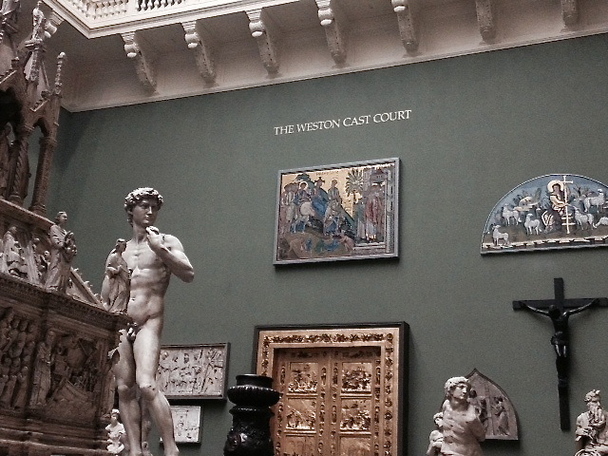David is back! At the end of last year the V&A re-opened the Weston Cast Court, one of its famous two Cast Courts, after years of restoration and repainting. Among the treasures that have been under wraps are the much-loved plaster cast of Michelangelo’s statue of David. The original, in Florence, was created in 1501-04; the plaster cast was made in about 1867, when plaster reproductions were all the rage. Few Victorians could afford to do the Grand Tour of Europe and see the original works, and these plaster casts were studied by artists and the casually curious. They fell out of favour in the 20th century, and many collections were destroyed. At the V&A, the plaster casts were housed in the two purpose-built cast courts – 24-metre-high rooms, tall enough to house the cast of Trajan’s column, albeit in two sections. The 35-metre-high original in Rome has eroded, and the V&A’s copy allows researchers and other to study the carvings in detail. The casts have survived because these Cast Courts had no other purpose. They are now, as Polly Toynbee points out, “ safely passed the danger zone because they have turned old, rare and precious in themselves.” | “Opened in 1873, these high glass-roofed courts were built to house gigantic casts of Europe's greatest monuments, an array of the gothic, the classical and the renaissance, incongruously hugger-mugger. A huge Celtic cross, a Pisano pulpit, an intricately carved Norwegian doorway, knight crusader effigies from English churches, a lion from Brunswick, the gates of paradise from Florence, Byzantine mosaics from Ravenna, centuries and nations apart.” Polly Toynbee, The Guardian, 13 November 2014 |
 Photo © V&A, Museum no: REPRO.1857A-161
Photo © V&A, Museum no: REPRO.1857A-161 The V&A says that in the early years of the museum, tin fig leaves were used on other nude statuary, but the authorities at South Kensington dismissed later objections, noting that "The antique casts gallery has been very much used by private lady teachers for the instruction of young girl students and none of them have ever complained even directly."


 RSS Feed
RSS Feed
